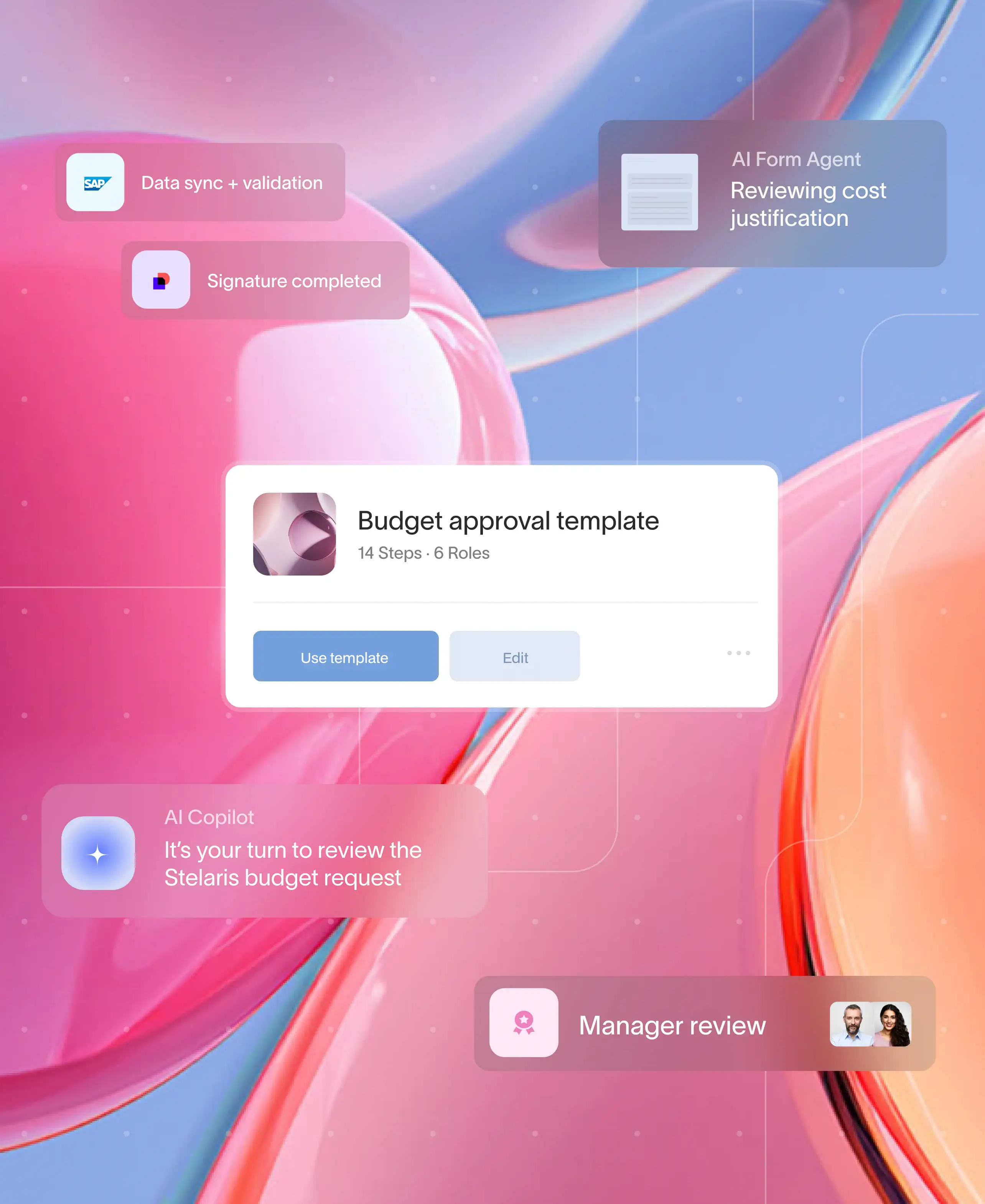.webp)
Invoicing clients accurately is crucial for any business, SaaS company, or B2B enterprise. A well-organized invoicing process ensures timely payments, maintains positive client relationships, and sustains cash flow. Conversely, mishandling invoices can lead to payment delays, cash flow problems, and even strained client relationships.
This guide will provide actionable steps and tips to master the art of invoicing for services. You'll have a comprehensive understanding of how to invoice clients effectively for smooth business operations.
What is invoicing
Invoicing a client means sending a detailed bill for goods or services provided. It's a formal payment request and serves as a critical document in the financial operations of any business. An invoice outlines what was delivered when it was delivered, and how much the client owes.
Invoices are not just simple bills; they also serve as legal documents that can be used in accounting, tax reporting, and auditing. A well-prepared invoice can streamline financial tracking and ensure both parties are clear on the terms of the transaction.
To ensure the effectiveness of your invoices, it is crucial to focus on three key elements:
- Itemization of services
- Clear communication of payment terms
- Timely delivery
1. Itemization of services
Itemization of services refers to providing a detailed breakdown of the products or services provided to the client. This includes descriptions, quantities, prices, and any additional fees such as taxes or shipping charges. It is important to be specific and transparent to avoid confusion and disputes over charges.
2. Clear communication of payment terms
One of the most important aspects of invoicing someone is to communicate the payment terms. This includes specifying the due date for payment, acceptable forms of payment, and any late fees or discounts offered. By clearly outlining these terms upfront, you can avoid any misunderstandings or delayed payments.
3. Timely delivery of invoices
Invoices should be sent out as soon as the work has been completed or products have been delivered. A delay in sending invoices leads to a delay in receiving payments and can negatively impact your cash flow.
By focusing on these key elements, you can ensure clients understand charges and payment expectations. Being proactive and transparent in invoicing helps avoid potential issues and maintain positive client relationships.
How to invoice a client
Creating and managing invoices can seem daunting, especially for small businesses. In this section, we will explore the steps involved in invoicing a client. Follow the steps below to invoice a client efficiently:
- Get to know new clients
- Use professional invoicing software
- Create an invoice template to reuse
- Clearly state payment terms
- Offer multiple payment options
- Review and send the invoice
- Get to know the accounting teams
- Track invoices and establish an invoice filing system
- Thank the client
- Follow up on unpaid invoices
1. Get to know new clients
Before you invoice a client, understand their needs and preferences. Establish a good relationship to set the stage for smooth transactions. Confirm the client's billing address, preferred payment methods, and any specific invoicing requirements they might have.
Different clients may prefer different payment methods. Some might prefer bank transfers, while others might opt for credit card payments or digital wallets. Understanding their preferences can speed up payment processes and improve client satisfaction.
2. Use professional invoicing software
Investing in professional invoicing software can save time and reduce errors. Software like Moxo allows you to send, sign, and track invoices seamlessly. It also provides reminders for unpaid invoices and integrates with other financial tools.
3. Create an invoice template to reuse
Always use an invoice template to ensure efficiency and consistency when sending an invoice to a client. A well-designed invoice not only looks more polished but also conveys professionalism.
Essentials of an invoice template
Your invoice template should include:
- Business information: Your company's name, address, and contact details.
- Client information: The client's name, billing address, and contact details.
- Invoice number: A unique identifier for each invoice.
- Date of issue and Due Date.
- Itemized list of services or products with descriptions, quantities, and prices. Break down the charges on your invoice by itemizing each service or product provided.
- Total amount due.
- Payment terms and methods: Clearly state the payment terms on your invoice, such as when the payment is due and what forms of payment you accept.
- Additional notes or instructions: Accepted payment methods, any additional fees or discounts applied.
4. Clearly state payment terms
Be explicit about when the payment is due and any penalties for late payments. This clarity helps prevent misunderstandings and encourages timely payments.
5. Offer multiple payment options
Provide various payment options to make it easier for clients to pay you. Consider accepting bank transfers, credit cards, and digital payments to accommodate different preferences.
6. Review and send the invoice promptly
The sooner you send an invoice, the sooner you're likely to get paid. Make it a habit to send invoices immediately after the service is rendered or the product is delivered.
Leave nothing to interpretation. Avoid ambiguities to prevent delays and disputes. Before sending out the invoice, take some time to review it for accuracy. Double-check all the information, especially numbers and dates, to avoid any errors that could delay payment. Send the invoice to the client only when you are satisfied with it.
7. Get to know the accounting teams
In large organizations, the person who hired you might not be processing your invoice. Establish a relationship with the accounting team to ensure your invoices are processed smoothly and promptly.
8. Track invoices and establish an invoice filing system
Keep a record of all sent invoices and their statuses. Use invoicing software to track which invoices have been paid and which are still outstanding. An organized filing system is crucial for easy retrieval of invoices. Whether digital or physical, ensure you can quickly locate any invoice when needed.
9. Thank to the client
A simple thank-you note after receiving the payment can go a long way in maintaining a positive client relationship. It shows appreciation and encourages future business.
10. Follow up on unpaid invoices
If a payment is overdue, follow up promptly. Send a gentle reminder and, if necessary, escalate your communication. Consistent follow-up shows that you take your business seriously. Always have a plan for late payments or disputes. Clearly outline late fees in your payment terms and have a follow-up procedure in place.
By following these steps, you can ensure that your invoices are professional, organized, and easy for both you and your clients to understand. This will not only help you get paid on time but also maintain positive relationships with your clients.
Why is it important to manage invoices efficiently?
Effective communication and efficient invoicing management are crucial for any business. It ensures timely payments, reduces the risk of disputes, and provides a clear record of all financial transactions.
Moxo combines client communication and invoicing management to streamline your workflow and improve overall business efficiency. You can automate client payment reminders, maintain regular touchpoints, enable electronic invoice signatures, and track invoice statuses through workflows. Moxo helps you stay on top of your finances while strengthening client relationships and streamlining financial oversight. Learn more about Moxo.
Conclusion
Invoicing a client correctly is crucial. You can ensure timely payments, maintain positive client relationships, and streamline your financial operations. Platforms like Moxo can further enhance your invoicing process, by providing valuable features that simplify and automate many of the tasks involved.
Take the next step in mastering client invoicing by integrating Moxo into your business. With its comprehensive features, you'll find invoicing clients more manageable and efficient than ever before. Get in touch!
FAQs
What information should be included in an invoice?
An invoice should include detailed information about the goods or services provided, the due date for payment, accepted forms of payment, and any additional fees or charges. It's also essential to have your contact information and the client's contact information for easy communication.
How should I organize my invoices?
It's crucial to have a system in place for organizing your invoices, whether it's through a spreadsheet or invoicing software. This will help you keep track of all outstanding payments and easily identify any late or unpaid invoices. It's also helpful to number your invoices sequentially for easier tracking and reference.
What is the best way to invoice clients?
The best way to invoice clients is by using professional invoicing software that allows you to create, send, and track invoices effortlessly. Ensure your invoices are clear, detailed, and sent promptly. Offering multiple payment options can also facilitate timely payments.
How can I handle late payments effectively?
To handle late payments effectively, clearly state late fees in your payment terms and enforce them consistently. Send prompt follow-up reminders and maintain communication with the client. Using softwares like Moxo to automate payment reminders and track payment statuses.





